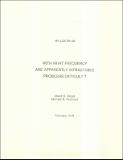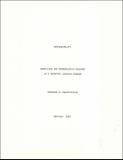Browsing Computer Science and Artificial Intelligence Lab (CSAIL) by Title
Now showing items 3774-3793 of 3804
-
Why Conniving is Better than Planning
(1972-02-01)A higher level language derives its great power form the fact that it tends to impose structure on the problem solving behavior for the user. Besides providing a library of useful subroutines with a uniform calling ... -
Why Conniving is Better than Plannng
(1972-04-01)This paper is a critique of a computer programming language, Carl Hewitts PLANNER, a formalism designed especially to cope with the problems that Artificial Intelligence encounters. It is our contention that the ... -
Why Do We See Three-dimensional Objects?
(1992-06-01)When we look at certain line-drawings, we see three-dimensional objects. The question is why; why not just see two-dimensional images? We theorize that we see objects rather than images because the objects we see are, ... -
Why Stereo Vision is Not Always About 3D Reconstruction
(1993-07-01)It is commonly assumed that the goal of stereovision is computing explicit 3D scene reconstructions. We show that very accurate camera calibration is needed to support this, and that such accurate calibration is difficult ... -
Wicked Problems and Gnarly Results: Reflecting on Design and Evaluation Methods for Idiosyncratic Personal Information Management Tasks
(2008-02-10)This paper is a case study of an artifact design and evaluation process; it is a reflection on how right thinking about design methods may at times result in sub-optimal results. Our goal has been to assess our decision ... -
Wide-Area Egomotion Estimation from Known 3D Structure
(2006-01-09)We describe an algorithm that takes as inputs a coarse3D model of an environment, and a video sequence acquiredwithin the environment, and produces as output an estimateof the cameraÂ’s 6-DOF egomotion expressed in the ... -
Width-3 Permutation Branching Programs
(1985-12)We consider a restricted class of width-3 branching programs where each column of nodes depends on a single variable, and the 0-edges and the 1-edges out of each column form a permutation. In this model, parity and the ... -
WIRElist
(1969-01-01)This memo describes a design aid used for the automatic production of wirelists for machine or hand wiring of wire-cards. -
With what Frequency are Apparently Intractable Problems Difficult?
(1979-02)An algorithm is almost polynomial-time (apt) iff there is a polynomial p such that for all n, the algorithm halts within p(n) steps on all by at most p(n) inputs of size at most n. It is nown that for NP-complete and ... -
Workshop on the Design and Control of Dextrous Hands
(1982-04-01)The Workshop for the Design and Control of Dexterous Hands was held at the MIT Artificial Intelligence Laboratory on November 5-6, 1981. Outside experts were brought together to discuss four topics: kinematics of hands, ... -
Workstation Services and Kerberos Authentication at Project Athena
(1989-03)This document proposes solutions for two problems obstructing Project Athena's implementation of workstation services. The principal problem is that workstation services demand a more flexible mutual-authentication ... -
World Wide Web Without Walls
(2007-08-24)Today's Web is built upon a particular symbiotic relationship betweensites and users: the sites invest capital to create and market a setof features, and users gain access to the sites often in exchange fortheir data (e.g., ... -
Worms of Ganymedes - Hazards of Image "Restoration"
(MIT Artificial Intelligence Laboratory, 1980-09) -
Worst-case and Probabilistic Analysis of a Geometric Location Problem
(1980-02)We consider the problem of choosing K "medians" among n points on the Euclidean plane such that the sum of the distances from each of the n points to its closest median is minimized. We show that this problem is NP-complete. ... -
Wrist-Partitioned Inverse Kinematic Accelerations and Manipulator Dynamics
(1983-04-01)An efficient algorithm is presented for the calculation of the inverse kinematic accelerations for a 6 degree-of-freedom manipulator with a spherical wrist. The inverse kinematic calculation is shown to work synergistically ... -
Write Barrier Removal by Static Analysis
(2002-02) -
Writing and Representation
(MIT Artificial Intelligence Laboratory, 1988-09)This paper collects several notes I've written over the last year in an attempt to work through my dissatisfactions with the ideas about representation I was taught in school. Among these ideas are the notion of a 'world ... -
Wumpus Advisor 1: A First Implementation Program that Tutors Logical and Probabilistic Reasoning Skills
(1976-10-01)The Wumpus Advisor program offers advice to a player involved in choosing the best move in a game for which competence in dealing with incomplete and uncertain knowledge is required. The design and implementation of ... -
Wumpus Protocol Analysis
(MIT Artificial Intelligence Laboratory, 1977-08)The goal of this research was to assist in the creation of a new, improved Wumpus advisor by taking protocols of ten people learning to play Wumpus with a human coach. It was hoped that by observing these subjects learn ... -
Wusor II: A Computer Aided Instruction Program with Student Modelling Capabilities
(1977-05-01)Wusor II is the second program that has been developed to tutor students in the game of Wumpus. From the earlier efforts with Wusor I it was possible to produce a rule-based expert which processed a relatively complete ...



















